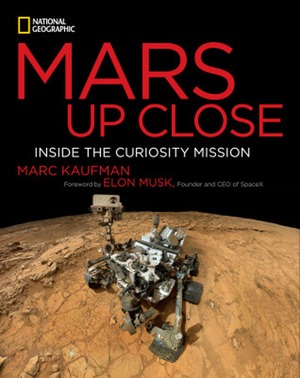Review: Mars Up Closeby Jeff Foust
|
| “The feeling is palpable at JPL: Something extraordinary is under way, an endeavor where the never ending challenge and burden of getting so many things right is routinely embraced because of the size of the prize.” |
This access perhaps shines best in a chapter not about the landing, which he does devote considerable detail to, but instead a near-death experience for the rover in February of last year. While the problem was reported as an “anomaly” that disrupted science observations for a time but might otherwise sound relatively minor, Kaufman was there as engineers struggled to overcome a computer problem. “Fear had gone to the highest levels, and the deadline was looming,” one engineer recalled. The rover, of course, was saved, but Kaufman describes a situation more tense and serious than might otherwise be understood.
The book discusses more than just Curiosity itself, describing the history of Mars exploration and the science involved, including the search for water, organics, and other signs that Mars was once habitable or even inhabited. As you would expect from a National Geographic book, Mars Up Close is lavishly illustrated, with color images on nearly every page of the large format book. That includes a series of original illustrations showing what one region of Gale Crater, Curiosity’s landing site, looked like in the past, present, and a possible near future where humans are also living there. One element of the book that falls short, though, are a series of one-page “Mission Makers” profiles of scientists and engineers involved in the mission: each devotes only a single paragraph to that person, hardly enough to get to know much about them.
The book’s foreword is contributed by Elon Musk, the founder of SpaceX who is interested in establishing a human presence—and even eventually retiring—on Mars, who makes that point in the brief section. “I am talking about people settling on Mars and making life interplanetary,” he writes. “When I think of going to Mars, I think of building greenhouses packed with rehydratable nutrients. I think of an iron-ore refinery. I think of a pizza joint.”
Kaufman’s own views about Mars exploration don’t come until the book’s final chapter, when he asks if missions like Curiosity are worth the effort. “My time embedded with the Curiosity mission has prejudiced me in favor,” he writes. “The feeling is palpable at JPL: Something extraordinary is under way, an endeavor where the never ending challenge and burden of getting so many things right is routinely embraced because of the size of the prize.” (He is, though, perhaps subtly skeptical of Musk’s long-term Mars settlement ambitions, calling Musk’s vision of human expeditions to Mars for $500,000 per person “a goal for the quite distant future.”)
It’s clear that Kaufman is enamored with the idea of sending missions like Curiosity to Mars, and with the women and men who make those missions possible. Mars Up Close, despite the name, offers a big-picture view of the exploration of the Red Planet with Curiosity, and why is can be so fascinating.
